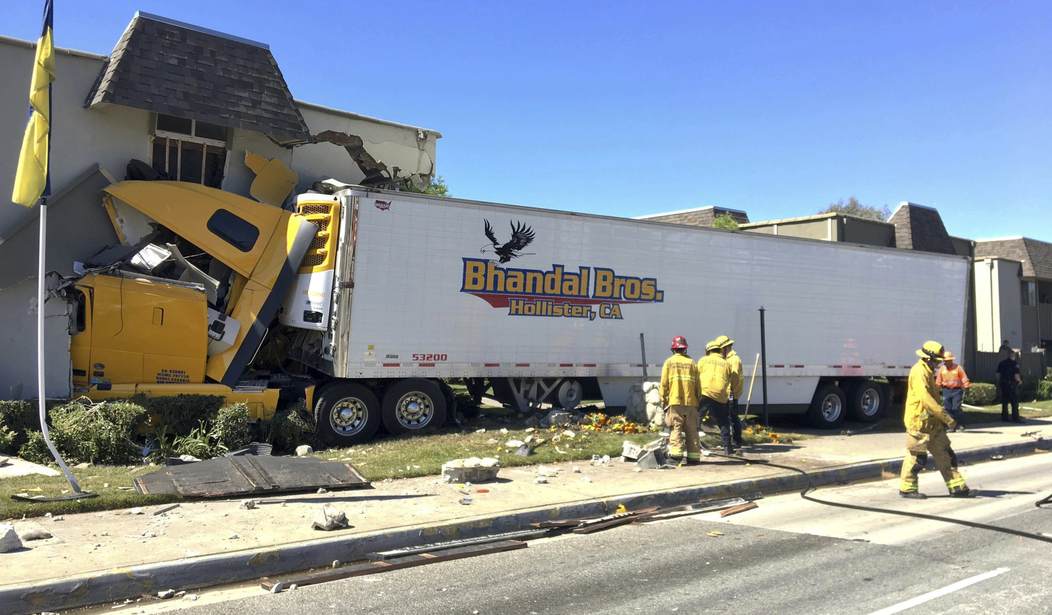WASHINGTON – Natalie Sanders’ husband, Brian Brown, was driving his pickup on a South Carolina highway in 2015 when a big-rig driver lost control of his tractor-trailer, crossed the median and killed him in a head-on collision.
“I’m stuck on one question – that if the truck that lost control and killed my husband had been equipped with automatic emergency braking, could that have saved his life?” Sanders said Tuesday on Capitol Hill.
Sanders and the Truck Safety Coalition are demanding that lawmakers push for trucking safety improvements as the White House draws up a projected $1 trillion infrastructure bill. President Trump said this week that the bill could be released before the end of the month.
The coalition — which is also advocating for speed-limit requirements, driver training reform and side-underride and front-override guard improvements – repeatedly pointed to statistics from the European Union, where automatic emergency braking technology has been required since 2012. According to the coalition, truck crash fatalities in the EU decreased by 23.4 percent between 2009 and 2014, while the U.S. saw an increase of 15.5 percent in the same span. The National Traffic Highway Safety Administration estimates that automatic emergency-brake technology could save 70 lives annually in the U.S. and prevent 3,500 serious injuries.
American Trucking Association spokesman Sean McNally said in an interview Tuesday that the industry is in support of deploying standard automatic emergency-brake systems, but he offered ATA statistics that show much more optimistic trends in the U.S. According to the ATA, the number of large truck-involved fatal crashes declined 32 percent between 1980 and 2015.
“Frankly, the long-term trend over the last decade-plus is positive,” McNally said, adding that the U.S. and the EU is not an apples-to-apples comparison, as EU vehicles are designed differently. “We’re proud of that, but more obviously needs to be done.”
Steve Owings, who appeared with the coalition Tuesday, lost his son Cullum in 2002 when a speeding tractor-trailer rear-ended him and his brother in Virginia. Owings is lobbying for speed limiters, which have been required in the EU since 1992, a mandate that inspired international manufacturers to start installing standard speed-limiting equipment.
“This realization infuriated me and my family,” Owings said. “Trucks in the United States have had a readily available safety technology already built in for decades.”
McNally said the industry supports limiting speeds for trucks across the U.S. He pointed out that the ATA in 2006 petitioned the government to enact a national speed limit for trucks at 68 mph.
The Department of Transportation and the National Highway Traffic Safety Administration have been working on a joint rule, which has included proposals for enacting speed limits ranging from 60 mph to 70 mph. ATA objected to the language in a draft version of the rule as they said it was too vague.
McNally said there has also been a trend across the U.S. in which states are increasing speed limits for other vehicles, from 65 to 70 mph to 75 mph to 80 mph. State Highway 130 in Texas now enjoys an 85 mph speed limit, McNally said, noting that the speed differential creates significant safety issues, not to mention that 85 mph is “far too fast for anyone.”
DOT closed its public comment period for the rule in December 2016, but it’s unclear when the agency will finalize new regulations.
Laurie Higgenbotham, who appeared with the coalition, lost her son Michael in 2014 when he collided with a truck making an illegal U-turn near Interstate 240 in Memphis, Tenn. The driver was slapped with a $50 fine for negligence. Higgenbotham has been advocating for side-underride and front-override guard improvements.
McNally said the industry is in support of strengthening underride guards in general, but has not taken a stance on side-underride guard improvements. The best underride guards, he said, are the ones that are never used.
He argued that in most crashes, the commercial driver is not at fault. He cited a Federal Motor Carrier Safety Administration Large Truck Crash Causation study, which was released in 2006 after three years of research and concluded that human error causes most truck crashes. McNally admitted it’s an old study, but says its findings hold up. The study concluded that 80 percent of crashes are due to human behavior, either on the part of the trucker or another driver. In more than two-thirds of the cases, fault was attributed to someone not driving the truck, McNally said.
“I think that’s an important baseline to establish,” McNally said, adding that the goal should be to prevent the crash in the first place.
Joan Claybrook, chairwoman for Citizens for Reliable and Safe Highways, agreed with the conclusion that the deaths and injuries are preventable, but she blamed lawmakers for pandering “to special interests at the peril of our safety.”
“This is contributing to long delays, repeated anti-safety attacks and outright dismissal of common-sense and overdue truck safety regulations,” she said.









Join the conversation as a VIP Member